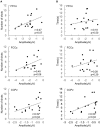Measuring Task-Related Brain Activity With Event-Related Potentials in Dynamic Task Scenario With Immersive Virtual Reality Environment
- PMID: 35185487
- PMCID: PMC8847391
- DOI: 10.3389/fnbeh.2022.779926
Measuring Task-Related Brain Activity With Event-Related Potentials in Dynamic Task Scenario With Immersive Virtual Reality Environment
Abstract
Measurement of event-related potentials (ERPs) in simulated and real environments is advantageous for understanding cognition and behavior during practice of goal-directed activities. Recently, instead of using task-irrelevant "probe stimuli" to elicit ERPs, extraction of ERPs directly from events that occur in simulated and real environments has drawn increased attention. Among the previous ERP studies using immersive virtual reality, only a few cases elicited ERPs from task-related events in dynamic task settings. Furthermore, as far as we surveyed, there were no studies that examined the source of ERPs or correlation between ERPs and behavioral performance in 360-degree immersive virtual reality using head-mounted display. In this study, EEG signals were recorded from 16 participants while they were playing the first-person shooter game with immersive virtual reality environment. Error related negativity (ERN) and correct-(response)-related negativity (CRN) elicited by shooting-related events were successfully extracted. We found the ERN amplitudes to be correlated with the individual shooting performance. Interestingly, the main source of the ERN was the rostral anterior cingulate cortex (ACC), which is different from previous studies where the signal source was often estimated to be the more caudal part of ACC. The obtained results are expected to contribute to the evaluation of cognitive functions and behavioral performance by ERPs in a simulated environment.
Keywords: behavioral performance; error-related negativity; event-related potential; immersive virtual reality; source localization; task-related event.
Copyright © 2022 Arake, Ohta, Tsuruhara, Kobayashi, Shinomiya, Masaki and Morimoto.
Conflict of interest statement
The authors declare that the research was conducted in the absence of any commercial or financial relationships that could be construed as a potential conflict of interest.
Figures



Similar articles
-
Reduced P300 in depression: Evidence from a flanker task and impact on ERN, CRN, and Pe.Psychophysiology. 2020 Apr;57(4):e13520. doi: 10.1111/psyp.13520. Epub 2020 Jan 3. Psychophysiology. 2020. PMID: 31898810
-
Using electrophysiological measures to evaluate the sense of presence in immersive virtual environments: An event-related potential study.Brain Behav. 2021 Aug;11(8):e2269. doi: 10.1002/brb3.2269. Epub 2021 Jun 26. Brain Behav. 2021. PMID: 34173347 Free PMC article.
-
Effects of virtual reality working memory task difficulty on the passive processing of irrelevant auditory stimuli.Neuroreport. 2023 Dec 6;34(17):811-816. doi: 10.1097/WNR.0000000000001958. Epub 2023 Oct 6. Neuroreport. 2023. PMID: 37823446
-
Neural Applications Using Immersive Virtual Reality: A Review on EEG Studies.IEEE Trans Neural Syst Rehabil Eng. 2023;31:1645-1658. doi: 10.1109/TNSRE.2023.3254551. IEEE Trans Neural Syst Rehabil Eng. 2023. PMID: 37028309 Review.
-
Making sense of all the conflict: a theoretical review and critique of conflict-related ERPs.Int J Psychophysiol. 2014 Sep;93(3):283-97. doi: 10.1016/j.ijpsycho.2014.06.007. Epub 2014 Jun 17. Int J Psychophysiol. 2014. PMID: 24950132 Review.
References
-
- Burns C. G., Fairclough S. H. (2015). Use of auditory event-related potentials to measure immersion during a computer game. Int. J. Hum. Comput. Stud. 73 107–114. 10.1016/j.ijhcs.2014.09.002 - DOI
LinkOut - more resources
Full Text Sources
Miscellaneous

